Kim Canonigo’s Stunning Portraits
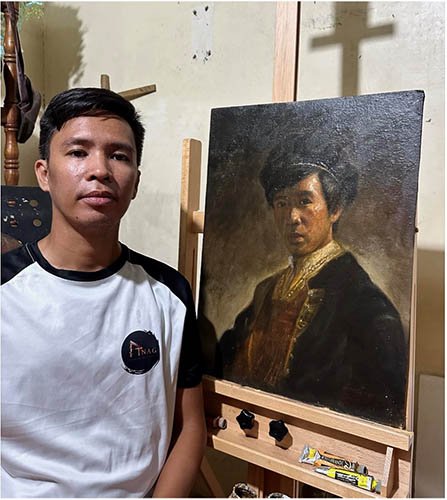
Kim Canonigo's portraits make people talk (Photo courtesy of Kim Canonigo)
Canonigo, born and bred in Toledo City, Cebu, is the eldest of five children. His grandparents raised him. “When I was a child, I always wondered, where were my parents,” he recalls. The love and attention that he received from his grandparents compensated for his solitude. Not many people have that kind of luxury. It is only now that he is getting to know his siblings.
He never thought he could draw. In second grade, at lunchtime, he tried copying a cow from a book onto a chalkboard. He was amazed that he succeeded. From then on, he always got excited copying from a book or photo.
Art as a career was far from Canonigo’s mind. He studied maritime transportation in college, dreaming of seeing the world. However, the direction of his life changed when he became a member of the Aroma Art Atelier, a group mentored by Orley Ypon. “Art became a feeling,” he tells me. “It needs to be expressed in any medium.” He then decided to become a full-time visual artist.
He can virtually do any painting. But his portraits have made him popular. Because he keeps doing more portraits, he has become better every day.
In Canonigo’s Akoni Castro Piraro (2023), soft light suffuses the subject’s face. Eleanor Modesto, an advertising icon in Manila, writes: “The portrait captures the innocence and wonder of a young child. I also like the delicate embroidery on the child’s barong tagalog.”
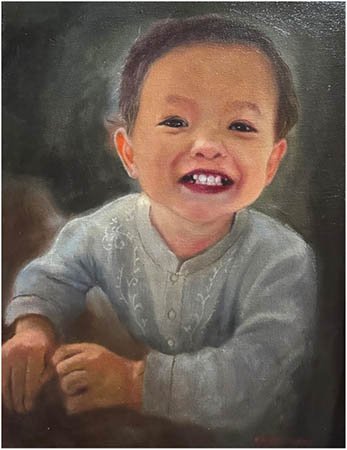
Akoni Castro Piraro, 2023, oil on canvas, 16" x 12" (Photo courtesy of Kim Canonigo)
Emmily Magtalas Rhodes, a writer in London, observes: “What a beautiful photo-realistic portrait! Akoni’s cheeky smile is so energetic—he seems to glow from within as he invites the viewer to witness his playful mischief.”
Genevie de Castro, a special-education teacher in Chicago, elaborates: “The boy’s eyes and smile are evocative. His expression reveals genuine excitement. He represents a young soul who is curious and ready to experience all the possibilities of life.”
Actor Paul Jake Paule was the storyteller in Rodolfo Vera’s play, Anak Datu (Chief’s Son), which was staged by Tanghalang Pilipino at the Cultural Center of the Philippines in 2023. Canonigo immortalized his rave performance in Paul Jake Paule: The Storyteller (2023). Gil Quito, a film scholar in New York City, calls it a “beautiful portrait with ethnic theme and striking, unique play of light.”
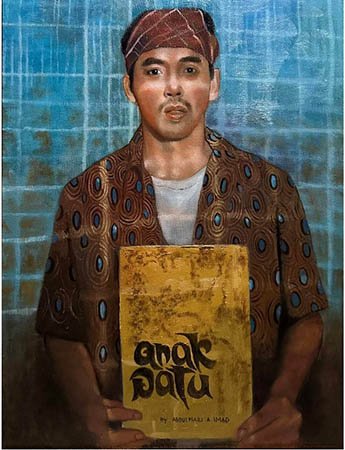
Paul Jake Paule: The Storyteller, 2023, oil on canvas, 24" x 18" (Photo courtesy of Kim Canonigo)
Dominic Agsaway, a children’s book illustrator in Manila, focuses on the portrait’s air of mystery: “The portrait encapsulates a storyteller in a seemingly enclosed space, which leads to a fruitful conversation with awe and thrill. Canonigo’s brush strokes imply a mastery of texture, giving his artwork a subtle sense of bewilderment that a viewer or listener can expect from the interesting subject.”
The portrait earns high praise from Nathan Regalado, a visual artist in Winnipeg: “Excellent portrait! The patterns on the clothing are exquisite along with its texture. The strong single-color background complements the figure well. However, the more intriguing element is the grid pattern from the light, a symbolic touch that makes this portrait a different piece!”
Kim Canonigo’s portraits are always conversation pieces. Viewers have different perspectives, and they have also raised questions.
Canonigo’s Dr. Jose Rizal (2022) presents the Philippines’ national hero from a different angle. Quito notes that the portrait has two firsts for him: “This is the first time I see Dr. Rizal with a rosary. This is also the first time I see him depicted with a lively, mischievous grin.”
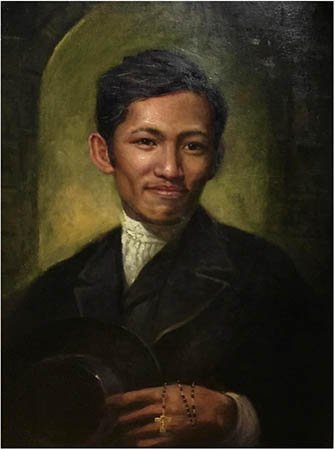
Dr. Jose Rizal, 2022, oil on canvas, 24" x 18" (Photo courtesy of Kim Canonigo)
Alex Arellano, an advertising guru in Manila, centers on the details: “The Rembrandt-like use of light and shadow draws the viewer’s attention to Dr. Rizal’s expression and his hands around which he has a rosary. It makes one wonder, why is Dr. Rizal smiling as he holds a rosary? In the late 19th century, everything religious was taken very seriously.”
Alvin Gaerlan, Ph.D., a psychologist in San Francisco, also finds the portrait to be in the style of Rembrandt because of its “dramatic light, exquisite brush works, and the attention to details.” He also notices how Dr. Rizal holds the rosary in his hand and dangles, rather than wrapped around his hand. However, Dr. Gaerlan asks a startling question: “Why is Dr. Rizal even holding a rosary? He was a Freemason. As such, he was not supposed to have subscribed to any religion.”
Kim Canonigo’s portraits are always conversation pieces. Viewers have different perspectives, and they have also raised questions. When people are talking, Canonigo is doing a great job. His portraits stop becoming inanimate. They instead become dynamic, stirring minds and hearts.
Kim Canonigo can be reached at kimpostrano600@gmail.com. The author wishes to thank Dexjordi Lyle Sison for his assistance in the photos.
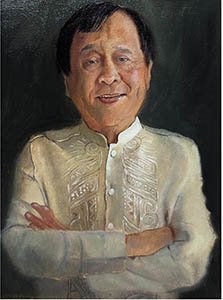
Rey E. de la Cruz, Ed.D., Positively Filipino correspondent, writes from Chicagoland when he is not loving the arts and longing for his hometown in the Philippines: Ballesteros, Cagayan. He was the first documented film student (University of the Philippines) and high-school film teacher (San Beda University) in the Philippines. An educationalist, he originated and disseminated the use of the ancient Philippine board game sungka as a teaching strategy. He was awarded the Gawad Balagtas for Drama in Filipino by UMPIL, the Philippines’ largest organization of writers, “for his pioneering creative spirit that imagined and expanded what can be possible for today’s modern theater.” Far-out dreams, visionary storytelling, and bold theatricality defined the plays he wrote and directed.
More articles from Rey E. de la Cruz



No comments: